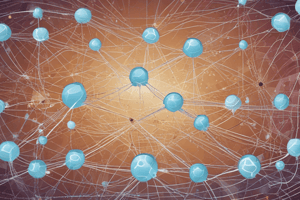Podcast
Questions and Answers
Why does segmenting an OSPF routing domain into multiple areas improve network scalability?
Why does segmenting an OSPF routing domain into multiple areas improve network scalability?
- It enables faster convergence times during network changes.
- It increases the frequency of LSA updates across the entire OSPF domain.
- It reduces OSPF traffic because routers outside an area do not have a complete topological map of that area. (correct)
- It allows all routers to maintain identical LSDBs, regardless of area.
What is the primary purpose of OSPF hello packets?
What is the primary purpose of OSPF hello packets?
- To establish the cost and path for routing data between networks.
- To encrypt OSPF communications for enhanced security.
- To discover and maintain neighbor relationships between OSPF routers. (correct)
- To flood LSA updates across the entire OSPF domain.
Which OSPF hello packet field is used to determine the router's role in DR/BDR election?
Which OSPF hello packet field is used to determine the router's role in DR/BDR election?
- Router ID (RID)
- Hello interval
- Interface address mask
- Interface priority (correct)
In OSPF, what is the significance of the 'Area ID' field within a hello packet?
In OSPF, what is the significance of the 'Area ID' field within a hello packet?
Which OSPF state involves routers exchanging link-state information using DBD packets?
Which OSPF state involves routers exchanging link-state information using DBD packets?
What happens during the 'Loading' state in OSPF adjacency formation?
What happens during the 'Loading' state in OSPF adjacency formation?
What condition defines the 'Full' state in OSPF adjacency formation?
What condition defines the 'Full' state in OSPF adjacency formation?
Why is a Designated Router (DR) and Backup Designated Router (BDR) used in multi-access OSPF networks?
Why is a Designated Router (DR) and Backup Designated Router (BDR) used in multi-access OSPF networks?
What is the role of the Backup Designated Router (BDR)?
What is the role of the Backup Designated Router (BDR)?
What occurs immediately after the DR fails in an OSPF network?
What occurs immediately after the DR fails in an OSPF network?
How does OSPF ensure secure communication between routers?
How does OSPF ensure secure communication between routers?
What does the 'Dead Interval' in an OSPF hello packet signify?
What does the 'Dead Interval' in an OSPF hello packet signify?
If a router runs multiple OSPF processes, what is true regarding the routing information?
If a router runs multiple OSPF processes, what is true regarding the routing information?
What is the significance of the OSPF process number?
What is the significance of the OSPF process number?
How does using a DR/BDR in OSPF affect the number of adjacencies formed in a multi-access network with four routers?
How does using a DR/BDR in OSPF affect the number of adjacencies formed in a multi-access network with four routers?
Which of the following is a valid representation of an OSPF Area ID?
Which of the following is a valid representation of an OSPF Area ID?
In the context of OSPF areas, what does Area 0 typically represent?
In the context of OSPF areas, what does Area 0 typically represent?
What is the purpose of the Authentication options field in the OSPF hello packet?
What is the purpose of the Authentication options field in the OSPF hello packet?
What is the initial state in forming an OSPF adjacency where routers identify which will be primary or secondary for LSDB synchronization?
What is the initial state in forming an OSPF adjacency where routers identify which will be primary or secondary for LSDB synchronization?
Which OSPF packet is used during the Exchange state to share link-state information?
Which OSPF packet is used during the Exchange state to share link-state information?
Flashcards
OSPF Area
OSPF Area
Divides an OSPF routing domain, hiding the exact topology of an area from outside, reducing OSPF traffic.
Router ID (RID)
Router ID (RID)
A unique 32-bit identifier within an OSPF domain, used to build a topology.
Authentication Options
Authentication Options
Used for secure communication between OSPF routers; options include none, clear text, or Message Digest 5 (MD5).
Area ID
Area ID
Signup and view all the flashcards
Interface Address Mask
Interface Address Mask
Signup and view all the flashcards
Interface Priority
Interface Priority
Signup and view all the flashcards
Hello Interval
Hello Interval
Signup and view all the flashcards
Dead Interval
Dead Interval
Signup and view all the flashcards
ExStart State
ExStart State
Signup and view all the flashcards
Exchange State
Exchange State
Signup and view all the flashcards
Loading State
Loading State
Signup and view all the flashcards
Full State
Full State
Signup and view all the flashcards
Designated Router (DR)
Designated Router (DR)
Signup and view all the flashcards
Backup Designated Router (BDR)
Backup Designated Router (BDR)
Signup and view all the flashcards
Study Notes
- An OSPF area's exact topology remains hidden from outside, while maintaining external router connectivity.
- Routers external to an area lack a complete topological map, which decreases OSPF traffic within that area.
- Segmenting an OSPF routing domain results in non-identical LSDBs across all OSPF routers.
- All routers within the same area will have identical area LSDBs.
- Reduced routing traffic due to segmentation leads to lower router memory and resource usage, enhancing scalability.
- A router can operate multiple OSPF processes, each having its own database.
- Routes from one OSPF process cannot be shared with another without redistribution.
- OSPF process numbers are locally significant and don't need to match between routers for them to become neighbors.
OSPF Hello Packets
- OSPF hello packets discover and maintain neighbors, typically sent to the AllSPFRouters address (224.0.0.5).
- Hello packets contain data such as Router ID (RID), authentication options, Area ID, interface address mask, interface priority, hello interval, and dead interval.
- Router ID (RID): A unique 32-bit ID within an OSPF domain for building the topology.
- Authentication options: Ensures secure communication; options include none, clear text, or Message Digest 5 (MD5).
- Area ID: The OSPF area an interface belongs to, represented as a 32-bit number in dotted-decimal (e.g., 0.0.1.0) or decimal (e.g., 256).
- Interface address mask: The network mask for the primary IP address of the interface sending the hello packet.
- Interface priority: Router interface priority for DR elections.
- Hello interval: Time, in seconds, that a router sends hello packets on an interface.
- Dead interval: Time, in seconds, a router waits for a hello from a neighbor before declaring it down.
OSPF Adjacency States
- Down: No information has been received from the neighbor.
- Attempt: Applicable to Non-Broadcast Multi-Access (NBMA) networks; manually configured neighbors are contacted.
- Init: Hello packets have been received, but bi-directional communication hasn't been established.
- 2-Way: Bi-directional communication is established; a router has seen itself in the neighbor's hello packet.
- ExStart: The first state, where routers decide who will be the primary or secondary for LSDB synchronization.
- Exchange: Routers exchange link states using DBD packets.
- Loading: LSR packets are sent to request more recent LSAs discovered (but not received) in the Exchange state.
- Full: Neighboring routers are fully adjacent.
Designated Router and Backup Designated Router
- Multi-access networks (Ethernet, Frame Relay) can cause scalability issues as the number of routers increases.
- More routers lead to additional LSA flooding and increased OSPF neighbor adjacencies.
- Using a Designated Router (DR) simplifies the network topology and reduces the number of adjacencies.
- If a DR fails, a Backup Designated Router (BDR) becomes the new DR; an election then occurs to replace the BDR.
- The BDR also forms full OSPF adjacencies with all OSPF routers on the segment to minimize transition time.
Studying That Suits You
Use AI to generate personalized quizzes and flashcards to suit your learning preferences.




